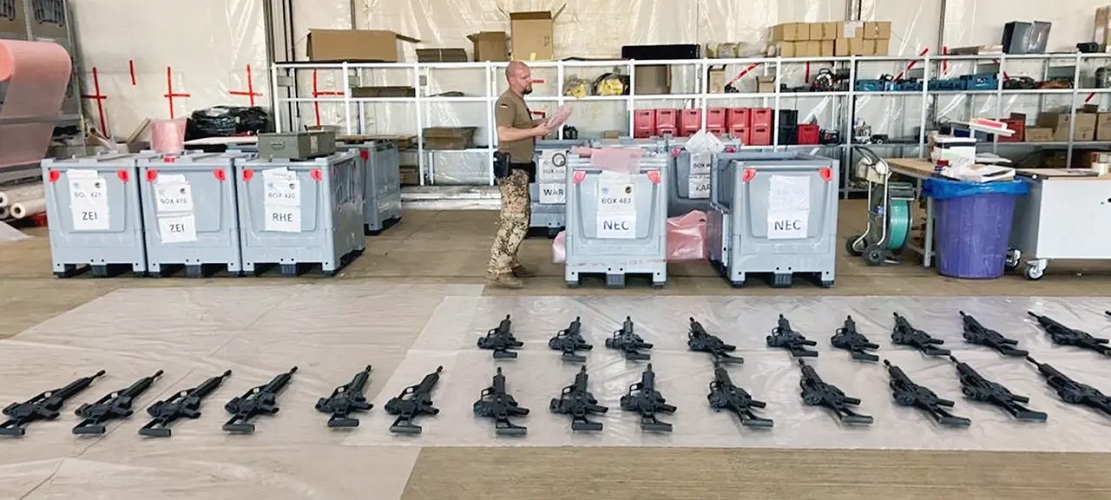No Simple Packing of Suitcases
The German Bundeswehr is faced with the daunting task of safely bringing back 700 soldiers, along with equipment encompassing approximately 600 containers, from Mali to Germany. This Herculean task is further compounded by the extremely limited time available.
From radios to Fuchs armored vehicles, the entire range of materials needed for the return journey to Germany is being prepared in a massive hall at the Bundeswehr camp in Gao, Mali.
Entering this so-called “material gateway” feels almost like entering an operating room. Pistols are meticulously dismantled and neatly laid out on film. Armored vehicles are thoroughly cleaned with disinfectants and protected against animal diseases to such an extent that it is difficult to fathom how just recently, Mali’s reddish desert sand could be found in every nook and cranny.
Spreading Terror Groups
At this moment, a soldier carefully wraps G36 assault rifles in shockproof bubble wrap and places them in specially secured crates. The G36, like all weapons, falls under priority one, which means it occupies the top spot on the scale of logistical importance ranging from one to five. It is absolutely crucial for the Bundeswehr to ensure that radios, weapons, or armored vehicles do not fall into the hands of spreading terrorist groups after their departure. Another concern is preventing these items from falling into the possession of Russian mercenaries who fight alongside the Malian army.
“Not a Three-Lane Highway”
The challenge is to reconcile the necessary caution with the tremendous time pressure. Commander Heiko Bohnsack admits in an interview with ARD, “The schedule is ambitious. Not much can go wrong, in fact, nothing can go wrong. We don’t have a three-lane highway here on which we can transport our forces and equipment back home.”
Instead of a highway, there is the airport in Gao, located right next to the German camp. As air transport is the safest option, the Germans and their A400M transport aircraft are heavily reliant on keeping this exit door open.
“The Gao airport is the biggest bottleneck,” says Thomas Henschke, Director of Material Redeployment. Henschke’s main problem is that there are many uncontrollable factors. If the weather or the Malian authorities do not cooperate, the schedule will be compromised.
Implications of the Security Situation
Ten days ago, at the airport in Gao, a Russian Ilyushin aircraft of the Malian army landed too late, rolled past the runway, and exploded on the red gravel behind it due to being seemingly overloaded.
Furthermore, fierce clashes continue between the Malian army and terrorist groups. According to logistics expert Henschke, they are dependent on the security situation — not because they are an immediate target, but due to the potential impact the ongoing battles may have on their logistics.
Following a bloody suicide attack in early September on a Malian army base just a few hundred meters from the German camp, flights were temporarily suspended for obvious reasons.
Readiness Until the End
Henschke and his team cannot control the escalating situation outside. However, they can ensure that the soldiers within the German camp are protected until the last minute. “This also means that we won’t prioritize bringing back items with the highest priority, such as our combat vehicles and weapons, first. Instead, combat vehicles and weapons will remain here until the end,” states Henschke.
Thus, this withdrawal remains a delicate balance until the very last minute. On one hand, ensuring the safe return of priority one materials is crucial. On the other hand, it is vital to have enough resources on-site to maintain the troops’ security.
Unfinished Hospital Left Behind
One thing that will definitely be left behind is the skeleton of a hospital in the middle of the Bundeswehr camp. Those who enter the building are surprised by how far they had come. The sinks and disinfectant bottle holders in front of the operating rooms are already installed, yellow LAN cables are laid, and the roof and walls are secured against rocket attacks.
The government had already spent over 26 million euros on the hospital when the decision was made earlier this year to not complete it due to the planned withdrawal. What could have been the most modern clinic in the Sahel region is now likely to remain the most expensive unfinished building.
Evacuation Plans
The goal is to transport 700 soldiers and goods equivalent to 600 containers back home, ideally by Christmas. Originally, there were 1,000 soldiers to be evacuated.
400 soldiers are already back home. But what happens if the situation becomes so threatening that a rapid withdrawal or even evacuation becomes necessary? It is a highly theoretical scenario, but plans are in place, assures Henschke.
However, these are plans that he is reluctant to discuss. One thing is certain: in such a case, even priority one materials on the list would have to be left behind in Mali. In that case, they would have to be destroyed on-site in a timely manner.

